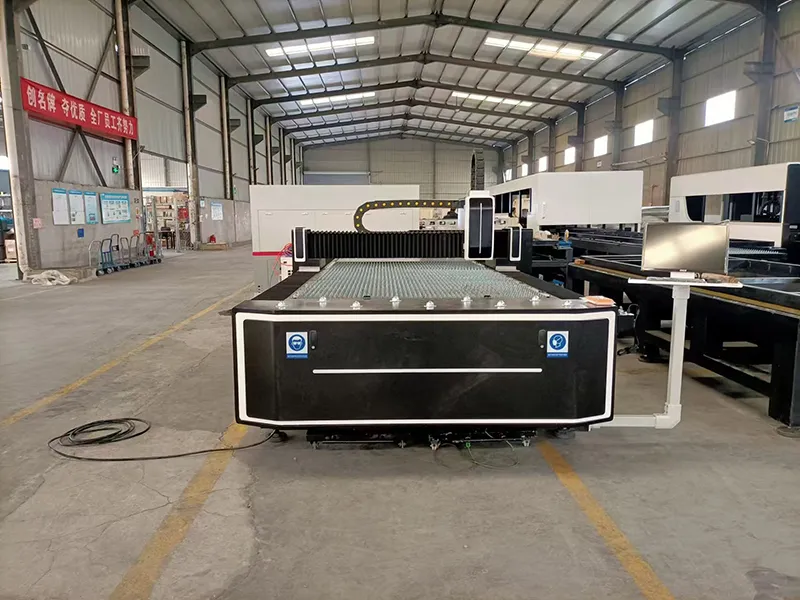As the core equipment of modern manufacturing industry, laser cutting equipment, its stable operation directly affects production efficiency. Based on many years of industry experience, Eagle Laser Equipment Co., Ltd. has specially compiled solutions to common faults of laser sheet cutting machine. Today we have covered ten typical problems to help you quickly restore your equipment to its best condition.
Ⅰ. Handling of unstable cutting:
When the cutting trajectory of the laser sheet cutting machine fluctuates, we should first check whether the air pressure and focus setting are too large at this time to avoid abnormal heating of the nozzle during the cutting process. At the same time, we must check the integrity of the nozzle and ceramic ring to exclude the possibility of loose or damaged parts. It is necessary to focus on observing whether the perforation link has burst holes, and to confirm that the surface of the processed material is free of rust pollution.
Ⅱ. Troubleshooting single-sided slag hanging:
In view of the problem of residual slag on one side of the workpiece, the focus position needs to be zeroed and calibrated, and the roundness of the nozzle needs to be verified at the same time. By adjusting the power parameters and duty cycle, the light spot is accurately positioned in the center of the nozzle. When the light spot offset is found, it needs to be corrected immediately, and finally the vertical accuracy of the cutting head is detected-this is the core element of the laser sheet cutting machine to maintain the cutting accuracy.
Ⅲ. Response plan for material impenetrability:
When the material cannot be cut through, follow the principle of triple verification:
1. Check whether the process parameter settings match the current material.
2. Check the blockage of the nozzle and the working status of the ceramic ring.
3. Confirm the accuracy of optical center positioning and protect the cleanliness of the lens.
Eagle Laser engineer's reminder: Regular maintenance is the key to ensuring the cutting depth of the laser sheet cutting machine.
Ⅳ. Solutions for perforation and perforation of thick plates:
The problem of perforation in thick plate processing can be alleviated by adjusting the perforation frequency and power duty cycle. Reduce the air pressure gradient according to the thickness of the plate (for example, ≤1.2Bar is recommended for 20mm carbon steel), and extend the time to stop the light and blow after perforation to more than 0.5 seconds. The status of the protective lens must be checked before turning on every day to ensure the stability of the optical system of the laser sheet cutting machine.

Ⅴ. Tumor elimination plan at the end of the knife:
For tumor-like residues that appear at the thick plate knife collection site, we recommend that the intelligent knife collection function of the 8000 system be enabled (standard configuration for high-end laser sheet cutting machine). The slow-starting and light-off delay functions are turned on synchronously, and the over-cutting compensation function is activated in the process settings. The recommended over-cutting amount is set to 10% of the board thickness.
Ⅵ. Enhanced glossy effect of carbon steel:
To improve the quality of carbon steel glossy cutting, a seven-step inspection of beam quality is required: Verify the integrity of the nozzle→ Clean the optical lens → Tape test the center of the light spot→ Calibrate the flatness of the plate→ Match the nozzle and focus → Analyze the spark jet pattern → Fine-tune the air pressure (the accuracy needs to be controlled at ±0.05Bar).
Ⅶ. Corner overburden control technology:
To solve the corner overburden of carbon steel plate, a dynamic process strategy is required: The corner cutting speed is reduced by 30%-50%, and the power attenuation curve is optimized through the control system. We recommend adding a cooling residence time of ≥1000ms at the corner, and activating the ring over-cutting function to effectively disperse the heat-affected area.
Ⅷ. Workpiece position misalignment diagnosis process:
When the position of the processed work is offset: We must first turn on the trajectory information collection function in the system to completely record the instruction data and servo feedback of the processing process. After locating the abnormal time node, compare the NC file with the original CAD image in three dimensions. Check the mechanical transmission gap or servo system calibration problem according to the deviation characteristics.
Ⅸ. Prevention of abnormal nozzle loss:
To reduce the nozzle loss under air cutting conditions, the sensitivity of the heightener needs to be increased by 50%, and a 0.2mm micro-link structure is added to the coplanar graphics during typesetting.Set the collision alarm delay to not exceed 200ms, appropriately reduce the vibration suppression level, and increase the nozzle height by 0.2mm. These measures can significantly extend the life of laser sheet cutting machine consumables.
Ⅹ. Main points of control of burrs on thin plates:
To eliminate burrs in thin sheet cutting, you need to follow the four laws of precision machining:
1. Ensure that the core components of the optical path system (optical core/nozzle/lens) are in the best condition;
2. Calibrate the zero focus position using professional equipment;
3. Strictly implement the recommended values of the process parameter table;
4. Special plates implement dynamic compensation of ±0.3mm focus and adaptive adjustment of ±10% cutting speed.

